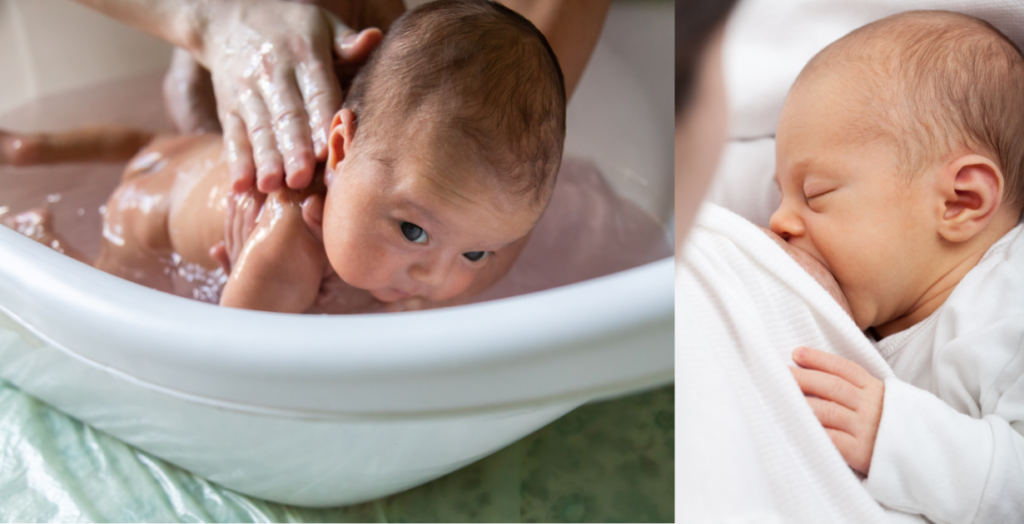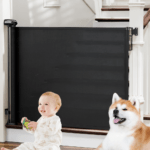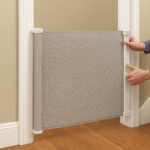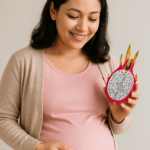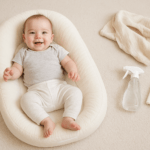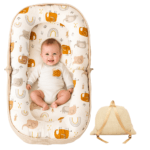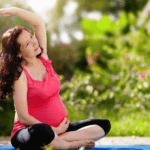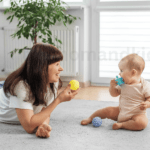Bathing your baby can be a sweet bonding moment, but knowing when to do it—especially after feeding—is important for your baby’s comfort and safety. Many new parents wonder how long it takes to wait after feeding before bathing their little one, and they are concerned about issues like spit-up or digestive discomfort. Babies have sensitive tummies, and bathing too soon after a meal can make them feel unsettled or lead to spit-ups, which is not ideal for a calming bath time experience.
Waiting a short while after feeding helps ensure your baby is relaxed, making bath time enjoyable and soothing. In this guide, we’ll explore recommended wait times after feeding, discuss how different types of feeding (like breast milk versus formula) might affect timing, and share tips for making bath time safe, stress-free, and fun. With the right timing, bath time can be a calming, joyful routine for you and your baby.
Overview of baby bathing routines and common concerns
Bathing a baby is a special part of the daily routine, but it comes with its own set of questions, especially for new parents. From figuring out how often to bathe a newborn to choosing safe products, each step requires some careful consideration. Newborns, for instance, don’t need daily baths; two to three times a week is generally enough to keep their skin clean without drying it out. As they grow, babies may enjoy more frequent baths, which can also be a relaxing bedtime ritual.
One common concern for parents is timing, particularly around feeding. Bathing too soon after a meal can cause discomfort or lead to spit-up, making it helpful to wait a bit after feeding. Additionally, parents often worry about water temperature, handling a slippery newborn, and keeping bath time enjoyable instead of overwhelming. With a little planning, bath time can become a safe, soothing experience that both baby and parent look forward to.
Read our Post: When to Start Bathing Your Baby Daily: A Guide for New Parents
Why Timing Matters When Bathing a Baby After Feeding
Timing plays a crucial role when it comes to bathing a baby after feeding. Babies have delicate digestive systems, and lying flat or moving around too much right after feeding can cause discomfort or lead to spit-up. When a baby’s tummy is full, a bath can make them feel unsettled, especially since water pressure on the belly or changes in position may add to their discomfort.
Waiting for a bit after feeding allows your baby to digest comfortably, reducing the likelihood of issues like reflux or spit-up during the bath. Bathing can also stimulate your baby, so giving them a short rest after eating helps ensure they’re calm and ready to enjoy the bath rather than feeling overstimulated.
Safe Wait Times Based on Age and Feeding Type

The recommended wait time before bathing your baby after feeding can vary depending on your baby’s age and whether they’re breastfed or formula-fed.
For newborns and babies under three months, it’s best to wait about 30-45 minutes after feeding before bathing them. Newborns have small stomachs and may need a bit longer to settle after eating. Babies who are breastfed may digest a bit faster, so you might be able to start the bath on the shorter end of this window.
For older infants who are more accustomed to feeding and digesting, a 20-30 minute wait is usually enough. Formula-fed babies, however, may take a bit longer to digest due to the composition of formula, so a wait time of closer to 30 minutes may help them feel more comfortable during bath time.
Signs Your Baby is Ready for a Bath
Knowing when your baby is ready for a bath can make the experience more comfortable and enjoyable for both of you. Here are a few signs to look for that show your baby is settled and ready for bath time:
- Calm and Relaxed Demeanor
If your baby is calm, alert, and not fussing, it’s often a good time for a bath. A relaxed baby is more likely to enjoy the warm water, making bath time peaceful and soothing. - No Signs of Discomfort or Fussiness
After a meal, babies sometimes show signs of discomfort like wriggling, squirming, or crying. Wait until they’ve settled down and aren’t showing these signs, as this indicates their digestion is progressing smoothly. - Burped and Comfortable
Make sure your baby has been burped well and isn’t showing signs of gas. A content belly reduces the chances of spit-up and discomfort during the bath. - Showing Interest in Bath Routine
Over time, babies can start to associate certain cues with bath time, like preparing their towel or filling the tub. If your baby seems alert and interested, they may be ready to ease into the experience. - Enough Time Has Passed Since Feeding
If you’ve waited the recommended time (typically 20-45 minutes, depending on age and feeding type), this is a good indication they’re ready. This buffer allows for comfortable digestion.
Ideal Bathing Routine Tips for New Parents
Creating a comfortable bathing routine for your baby can help make bath time a smooth, enjoyable experience. Here are some tips to establish a safe and soothing routine:
- Pick a Consistent Time
Babies often respond well to routines. Choosing a regular time, such as before bed, can help your baby associate bath time with relaxation and winding down. - Set Up Ahead of Time
Have everything you need within arm’s reach—like towels, washcloths, gentle baby soap, and a clean baby diaper—before starting. This way, you can give your full attention to your baby, keeping them safe and comfortable. - Use Warm, Not Hot, Water
Aim for a water temperature of around 98-100°F (37-38°C), which is warm but not hot. Test the water with your wrist or elbow to make sure it’s gentle on your baby’s sensitive skin. - Keep the Bath Short
For newborns and infants, 5-10 minutes is usually enough time. This helps prevent their skin from drying out and keeps the experience brief but pleasant. - Talk or Sing to Your Baby
Talking or singing softly during the bath can make your baby feel secure and create a calming atmosphere. It’s a simple way to bond while keeping them engaged. - Dry and Moisturize Immediately
After the bath, gently pat your baby dry with a soft towel. Apply a baby-safe moisturizer if needed to lock in moisture and keep their skin soft.
Is it Okay to Bathe a Baby Immediately After Feeding?

It’s generally not recommended to bathe a baby immediately after feeding. Babies have sensitive digestive systems, and a full tummy combined with the movements and position changes during a bath can lead to spit-up or discomfort. Here’s why waiting is usually a better choice:
- Risk of Spit-Up or Reflux
Bathing too soon after feeding increases the chances of your baby spitting up due to the gentle pressure of the water on their stomach or the position changes. Waiting allows for better digestion, reducing this risk. - Potential Discomfort
A bath right after feeding can feel uncomfortable for a baby with a full stomach. By waiting a bit, you’re giving your baby time to settle and digest, helping them feel relaxed and happy in the bath. - Bath as a Calming Activity
Bathing can be a soothing experience, especially when done after a short break post-feeding. By waiting, bath time becomes a relaxing part of their routine instead of something that could cause tummy troubles.
How long should I wait after feeding to bathe my baby?
It’s generally best to wait a bit after feeding to ensure your baby’s comfort during bath time. Here’s a quick guide to recommended wait times:
- For Newborns (0-3 Months):
Wait about 30-45 minutes after feeding before bathing. Newborns have small tummies, so giving them extra time helps prevent spit-up and discomfort. - For Older Infants (3+ Months):
Waiting 20-30 minutes is usually sufficient for older babies who are more accustomed to digesting after a feed. - Breastfed Babies:
Breast milk tends to digest faster, so the shorter end of the recommended wait time may work. For newborns, you may be fine with a 30-minute wait, while older infants might be ready after about 20 minutes. - Formula-Fed Babies:
Formula takes longer to digest, so waiting closer to the full recommended time (30-45 minutes for newborns, 30 minutes for older babies) can help ensure they’re comfortable during bath time.
What to Do If Your Baby is Gassy or Fussy After Feeding
If your baby is gassy or fussy after feeding, there are several soothing techniques you can try to help them feel more comfortable. Here’s what you can do:
- Burp Them Gently
Sometimes, gas is simply trapped air from feeding. Hold your baby upright and gently pat or rub their back. Try different positions—like over your shoulder or sitting on your lap—to find what works best for releasing gas. - Give a Tummy Massage
A gentle belly massage can help ease gas. Using two fingers, make small, clockwise circles on their tummy. This can help stimulate digestion and move gas along. - Try the Bicycle Legs Technique
Lay your baby on their back and gently move their legs in a pedaling motion, like they’re riding a bike. This movement can encourage gas to pass and provide relief. - Hold Your Baby Upright
Keeping your baby upright for 20-30 minutes after feeding can help reduce gas and discomfort by allowing gravity to aid digestion. - Swaddle or Use Skin-to-Skin Contact
Sometimes, just feeling close to you can calm a fussy baby. Swaddling or holding them skin-to-skin can provide comfort, reducing fussiness and helping them relax.
How to Balance bath time with nap and feeding schedules.
Balancing bath time with your baby’s nap and feeding schedules can be tricky, but with a little planning, it’s possible to create a smooth routine. Here are some tips to help you manage it:
- Plan Bath Time Between Feedings and Naps
Ideally, aim for bath time to fall between feedings and naps when your baby is calm and well-rested. If your baby feeds around the same time every day, schedule the bath after a feed but before their nap, when they’re less likely to be too full or too tired. - Consistency is Key
Try to keep bath time at the same time each day, such as before or after the evening feed. Babies thrive on routine, and consistency will help them associate bath time with relaxation and calm. - Allow Time for Digestion
After feeding, wait 20-45 minutes before bathing your baby to ensure digestion is underway. This prevents any discomfort during bath time. Afterward, you can follow up with a nap to help your baby feel relaxed and settle down. - Keep Bath Time Short and Sweet
Bath time doesn’t need to be long, especially for newborns and young babies. Aim for 5-10 minutes to avoid cutting into nap time. A quick but enjoyable bath can be enough to keep both of you on schedule. - Observe Your Baby’s Cues
Pay attention to your baby’s mood. If they’re becoming fussy before their nap or feeding, it might be better to skip the bath that day or reschedule it for another time. Adapt the routine as needed based on how your baby is feeling.
Conclusion
Bathing your baby is a special bonding time, and with a little attention to timing and routine, it can become an enjoyable experience for both of you. It’s important to give your baby time to digest after feeding to avoid discomfort and ensure they’re calm before entering the bath. By understanding your baby’s cues, creating a consistent schedule, and allowing the right amount of time between feedings, naps, and bath time, you can make bath time a soothing, enjoyable part of your daily routine. With patience and practice, both you and your baby will look forward to this peaceful moment together.
FAQs
- How long should I wait after feeding to bathe my baby?
It’s recommended to wait about 20-45 minutes after feeding, depending on your baby’s age and whether they are breastfed or formula-fed.
- Can I bathe my baby every day?
Newborns don’t need daily baths; two to three times a week is usually enough. As your baby grows, more frequent baths may become part of the routine.
- What temperature is safe for a baby’s bath?
The ideal water temperature for a baby’s bath is between 98-100°F (37-38°C). Always test the water with your wrist or elbow to ensure it’s not too hot.
- How do I keep my baby calm during bath time?
To keep your baby calm, speak or sing softly, use warm water, and ensure the bath is quick but comfortable. Being gentle and reassuring will help your baby relax.
- Are there any specific products to avoid for baby’s sensitive skin?
Avoid harsh soaps, fragrances, or products with strong chemicals. Opt for gentle, hypoallergenic baby bath products designed for sensitive skin.
